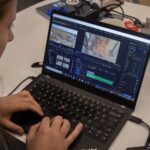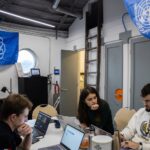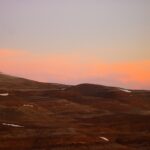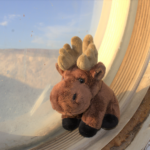Crew 275 Mid-mission research report 26Feb2023
Physics
Two experiments from the French National Center of Scientific Research (CNRS) have been performed at the MDRS for several years already. We are gathering additional data for this season as well. These activities require EVAs. There are three types of measurements: The Field Mill and Mega-Ares measure the electric field; the weather station measures wind and temperature; and the Purple Air instrument as well as the LOAC (Light Optical Aerosol Counter) collect and classify particles. The installation of these instruments was not easy, as the weather was not kind to us. After a long snow fall, we had to wait for the snow to melt completely so that we could set up the instruments safely. The Mega-Ares had a problem with its sphere-shaped antenna (no conductivity between the two hemispheres). We also had a problem with the battery wire of the Field Mill. All these problems required 4 EVA to set up all the instruments correctly. At Sol 13, we managed to simultaneously collect our first data with all the instruments.
Technology
Three technology demonstrations are planned, one of them being the continuation of last year’s mission of ISAE-Supaero (Crew 263). They are based on technologies developed by the French Space Agency (CNES) and its health subsidiary (MEDES), as well as a private company (Nucleus VR).
· AI4U: AI4U is an artificial intelligence designed by French space agency (CNES) and the company Spoon to assist the astronauts during their mission. We started to set up the main functionalities of « Ed » (its name), which is a depressurization alert assistant that helps us with the protocols in case of emergency. We tested the dialog flow to ease vocal recognition. With the environmental sensors installed on the whole campus, we will soon connect them to Ed so that it can inform us about the conditions at different locations through the station (humidity in RAM, or temperature in Greenhab, for instance).
· Echofinder: EchoFinder is an experiment conducted in collaboration with CNES, consisting in testing a protocol for astronauts to perform ultrasounds without any prior training. This experiment has already been conducted in the past by ISAE-Supaero crews. This year, the aim is to test a new Augmented Reality interface coupled with an organ detection AI. So far, we have gone through 6 sessions, each performed in pairs: the two crewmembers take turns in performing the ultrasound and being subject to the experiment. We have had several issues with this experiment, mainly because our hardware did not support the EchoFinder software very well. With the help of the researchers from CNES, our crew engineer managed to transfer the software to a more powerful device which has made the last two sessions much easier to perform. We aim to go through six more sessions to provide the researchers with a complete set of data, so they can evaluate the accuracy of their AI and how the AR interface can be improved.
· Digital twins: Evaluation of a digital twin training method to help astronauts using hardware and better visualizing how to fix or use an object. The aim of this experiment is to use a digital environment with a numerical 3D model of an object. However, we did not have time to work on this experiment so far.
Human Factors
Three human factor experiments are planned for this season. They are the result of a collaboration with the Swedish Royal Institute of Technology (KTH), the French Military Institute of Biomedical Research (IRBA), and the University of Burgundy (France).
· KTHitecture: Measure of the stress of analog astronauts and of the influence of environmental parameters on the stress. We successfully deployed environmental monitoring sensors to measure temperature, pression, humidity, and luminance in each room of the station. After the IRB review was accepted and forwarded to MDRS representatives, we started physiological measurements with chest band sensors (ECG, actigraphy) and psychometric tests. We are now finishing the implementation of the indoor location tracking system. The aim is to record the position of each crew member and hence have information concerning their environment when analyzing the data. Finally, the crewmembers regularly fill Sociomapping questionnaires about their social interactions, the crew’s atmosphere and performance, etc. In addition to the scientific interest of such maps, they enable us to detect social problems and enhance the global performance of the crew.
· ETERNITI: Study of the psycho-physio-cognitive functioning and of the benefits of transcutaneous auricular vagus nerve stimulation (taVNS) in the context of Mars analog missions. taVNS consists in a non-invasive stimulation of the vagus nerve at the level of the ear. It is a very encouraging candidate as a countermeasure to mitigate the harmful effects of future interplanetary missions and improve individual performance. In the recent years, taVNS has indeed shown its potential to reduce symptoms, improve cognitive performance, and enhance recovery. We did not start these protocols, as we have not received the IRB approval yet. The IRB came back to the investigators with the request to get a letter from the Mars Society mentioning that they had no problem implementing the experiment, should they accept it. We sent three emails to ask for such a letter from the Mars Society, but did not get any answer.
· Adapt Mars: Self-report questionnaires to explore some aspects linked to individual and social adaptation to isolated and confined extreme environments. The aim is to examine the social, emotional, occupational, and physical impact of these environments. Other objectives include: the impact on individual psychological adaptation factors (stress, recovery, defense mechanism, etc.) and interpersonal relationships (cohesion, leadership, etc.). We did not start these protocols, as we have not received the IRB approval yet.
Botany
Two botany experiments are taking place at the Green Hab. They are designed with the support of researchers from ISAE-Supaero and NASA.
· Aquapony: The aim of this experiment is to test aquaponics systems inside the Green Hab and to evaluate their viability in Mars analog missions. The aquaponics system has been in place since Sol 2. It works well, the water tests show a good environment for the fish. Plants are growing well; however, we can notice that the parsley is not really accommodating to it, and the basil shows a little bit of struggle too. We keep an eye on every plant growing and we can clearly see their roots are way denser than at the beginning of the mission. Overall, everything goes to plan.
· Microgreen: The idea behind this activity is to grow crops of microgreens in the Green Hab. One of the main advantages of microgreens is that they grow quickly and can be included in the food consumption of the crew. This experiment began late because we unfortunately did not receive the kit we should have started with. But as there are microgreens seeds in the GreenHab we decided to launch the experiment with these (Beta vulgaris seeds) on Sol 8. Since then, they have been calmly growing, we can now see their little leaves popping out of the dirt. Photographs have been taken to monitor their growth.
Geology & Exploration
Two geology and exploration experiments are being implemented and require dedicated EVAs. They have been prepared together with scientists from CNRS and ISAE-Supaero. One of the experiments includes the use of a drone for which a license has been obtained by a crew member (Quentin Royer).
· MetMet: Test of material used to measure the magnetic susceptibility and electrical conductimetry of rocks to rapidly assess their type. This material is currently used to differentiate meteorites from terrestrial rocks. This experiment started only on Sol 13, with an EVA to Kissing Camel Ridge W. The tested material was found to be very user-friendly, and the EVA was overall a great success. A lot of samples were taken thanks to this field work. They will be studied further next week. Another EVA is planned at the end of the week to couple both geology and photogrammetry information.
· Photogrammetry: Test of the added value of having a 3D map of a terrain (mapped with a drone from Parrot) to prepare EVAs and facilitate exploration. These tests include the localization and identification of specific points of interest during EVAs, with prior familiarization with a 2D map or a 3D render of the terrain. We conducted 3 EVAs related to photogrammetry during the second week. Photogrammetry of the North Ridge area was performed during the first of these EVAs. Two additional ones were then performed, and Crew members who had access to either a 2D map or a 3D render had to find predefined checkpoints in the field. We measured the accuracy and efficiency to find the checkpoints. At least 3 more EVAs will be performed during the 2nd half of the mission, in order to reproduce the same process on a different field.
Biology
One biology experiment has been prepared with the university of Hawaii and makes use of the EVAs planned already for the MetMet experiment.
· Biofinder: The aim of this experiment is to identify traces of life with a fluorescence technology instrument during EVA. The first samples were taken during the EVA of Sol 13 and will be studied during the next week. Another EVA is planned at the end of week three to collect more samples.
Astronomy
One astronomy project has been prepared with Peter Detterline at the Mars Society.
· Asteroid characterization: The aim of this project is to measure the lightcurve, velocity, and rotation rate of pre-identified asteroids. It makes use of robotic observatory available at the MDRS. Because of the cloudy weather, this project has not really started so far. We hope the weather conditions will improve in the next days so that the first observations can be performed.








You must be logged in to post a comment.